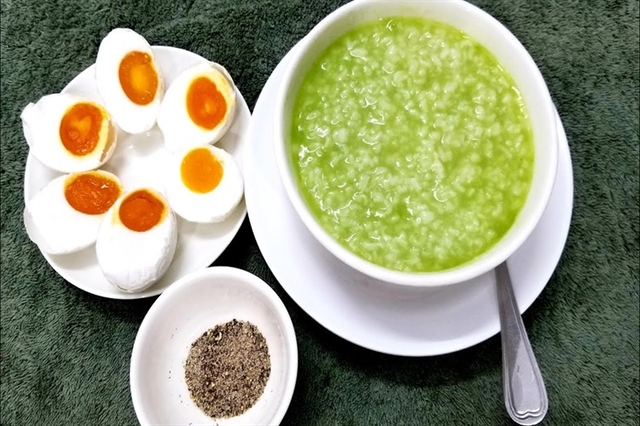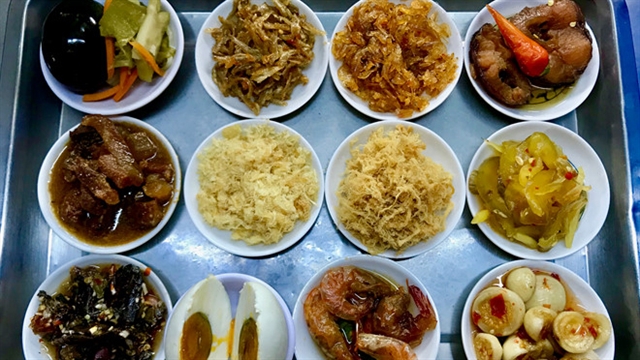 Life & Style
Life & Style

Thanh Hà
Vietnamese chefs are incredible talented when it comes to knowing how to use pandan leaves, a queen of flavour, to cook hundreds of tasty great and amazing dishes.
The city of Sài Gòn is famed worldwide, not only for its wonderful location – often described as a 'Pearl of the Far East', but also its abundant culinary spread, from vermicelli soups, wild forest leaf hotpot and, also many different types of porridge, such as rice porridge with aromatic fragrant of pandan leaves or cháo trắng lá dứa.
Nguyễn Thị Thuần, a teacher from Hà Nội, recently visited Sài Gòn (also known as HCM City) and said she particularly enjoyed a pause from her travels by eating a bowl of the local speciality. She said: “I feel quite relaxed after wandering along Sài Gòn streets, enjoying a bowl of rice porridge with that amazing aromatic flavour of pandan leaves.

|
| Rice porridge with pandan leaves is very enjoyable when eaten with salted duck eggs. — Photo fptshop.com.vn |
“I witnessed as a solo traveller that 'Sài Gòn has no night', because bustling shops and stands are busy even after dark, serving amazing dishes to foodies, visitors and travellers including foreign tourists, throughout the night time," Thuần said.
“The dish is healthy and easy to eat so all people from young to old, from high class diners to poor labouring workers, like the dish. This popular dish is even more enjoyable when eaten with traditional dishes such as salted duck eggs.”
Seller Hoàng Thị Hạnh said the dish is a favourite breakfast for the elderly and patients recovering from illness, along with being a popular dish of a younger crowd at night.

|
| An attractive plate of salted duck eggs. — Photo fptshop.com.vn |
Ingredients to cook the dish include new-harvested ordinary rice, sticky rice, pandan leaves and it can be served with salted duck eggs, braised pork, fermented pickles, braised fish, fried baby shrimp and coconut juice.
A perfect dish is in light green colour, without being overcooked to retain the form of the rice. The leading characteristics are that it is fragrant from the pandan leaves and sweet from the rice.
Hạnh told Việt Nam News her culinary secrets of how to cook a tasty great pot of the dish. “Cooks should choose older pandan leaves instead of young ones, which have a nicer green colour and they should use long and white ordinary rice and sticky rice to create the best porridge texture."

|
| Other dishes eaten with rice porridge include fried baby shrimp and braised fish. — Photo cooky.vn |
She added that the dish is even tastier when cooks soak the rice over night or fry the grains first to a pale yellow colour, before it is cooked. The pandan leaves should be soaked in warm water for ten minutes to prevent any bitterness.
Apart from porridge, pandan leaves are to go-to ingredient for many chefs, to add a wonderful fragrance to any dish. They are key in cooking many sorts of cakes and dishes such as tube cake with pandan leaves, sticky rice with pandan leaves and roasted chicken with pandan leaves, along with many others, said Hạnh.
Herbalist Nguyễn Công Đức from HCM City’s University of Medicine and Pharmacy said pandan leaves help to prevent constipation, protect people from colds, stimulate appetites and offer a way for a quicker health recovery after an illness.

|
| Foodies like sticky rice with pandan leaves and coconut threads. — Photo anhp.vn |
“It is also effect in treating diabetes,” he said.
Pandan leaves have been widely planted in Southeast Asia and aside from being widely used as a popular cooking ingredient, they have been included in traditional herbal medicines in the region for hundreds of years, according to the Việt Nam Journals of Science.
In 1832, the leaf’s scientific name, pandannus amaryllifolius, was first mentioned in documents of Scotland botanist William Roxburgh, when he described a small bush of pandan leaves being grown in Indonesia’s Maluku Province. — VNS




